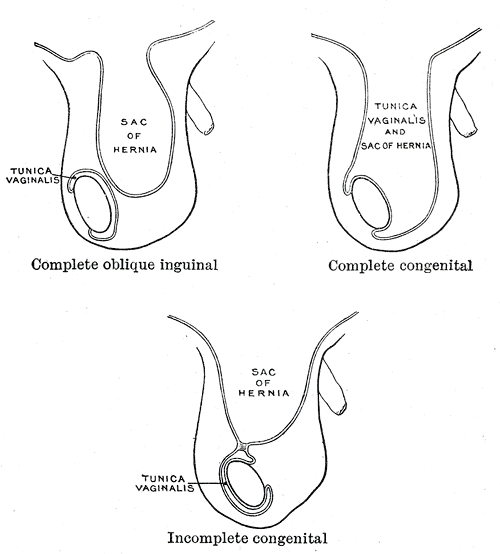Inguinal hernia overview
|
Inguinal hernia Microchapters |
|
Diagnosis |
|---|
|
Treatment |
|
Case Studies |
|
Inguinal hernia overview On the Web |
|
American Roentgen Ray Society Images of Inguinal hernia overview |
|
Risk calculators and risk factors for Inguinal hernia overview |
Editor-In-Chief: C. Michael Gibson, M.S., M.D. [1]
Overview
Inguinal hernias (Template:IPAEng) are protrusions of abdominal cavity contents through the inguinal canal. They are very common and their repair is one of the most frequently performed surgical operations.
There are two types of inguinal hernia, direct and indirect. Direct inguinal hernias occur when abdominal contents herniate through a weak point in the fascia of the abdominal wall and into the inguinal canal. Indirect inguinal hernias occur when abdominal contents protrude through the deep inguinal ring; this is ultimately caused by failure of embryonic closure of the internal inguinal ring.
Historical Perspective
Reinforcement of the anterior wall of the inguinal canal and tightening of the external inguinal ring was first discovered by Stromayr in 1559. In 1871, new use of carbolized catgut ligature was developed by Marcy to treat inguinal hernia. Twisted and suture-transfixed the peritoneal sac in the lateral muscles through the external ring was developed by Kocher to treat inguinal hernia.
Classification
Reinforcement of the anterior wall of the inguinal canal and tightening of the external inguinal ring was first discovered by Stromayr in 1559. In 1871, new use of carbolized catgut ligature was developed by Marcy to treat inguinal hernia. Twisted and suture-transfixed the peritoneal sac in the lateral muscles through the external ring was developed by Kocher to treat inguinal hernia.
Pathophysiology
Directed inguinal hernia is caused by protrusion through Hesselbach triangle, passes medial to inferior epigastric vessels. Indirected inguinal hernia is caused by passes through internal inguinal ring, traverses inguinal canal to external ring, and may extend into scrotum in males and labia major in females.
Causes
Common causes of inguinal hernia include combination of increased pressure within the abdomen and a pre-existing weak spot in the abdominal wall, chronic coughing or sneezing, heavy lifting such as weightlifting, abdominal wall defects and advanced age.
Differentiating Inguinal hernia overview from Other Diseases
Epidemiology and Demographics
Risk Factors
Screening
Natural History, Complications, and Prognosis
Natural History
Complications
Prognosis
Diagnosis
Diagnostic Criteria
History and Symptoms
Physical Examination
Laboratory Findings
Imaging Findings
-
Different types of inguinal hernias.
-
Inguinal fossae
Other Diagnostic Studies
Treatment
Medical Therapy
Surgery
The inability to "reduce" the bulge back into the abdomen usually means the hernia is "incarcerated," often necessitating emergency surgery. Recent data questions the routine elective repair of all inguinal hernias. Some studies indicate that inguinal hernias can be left alone with no greater risk than prompt elective treatment. Nevertheless, the bias remains toward surgical repair. Provided there are no serious co-existing medical problems, patients are advised to get the hernia repaired surgically at the earliest convenience after a diagnosis is made. Emergency surgery for complications such as incarceration and strangulation carry much higher risk than planned, "elective" procedures.

